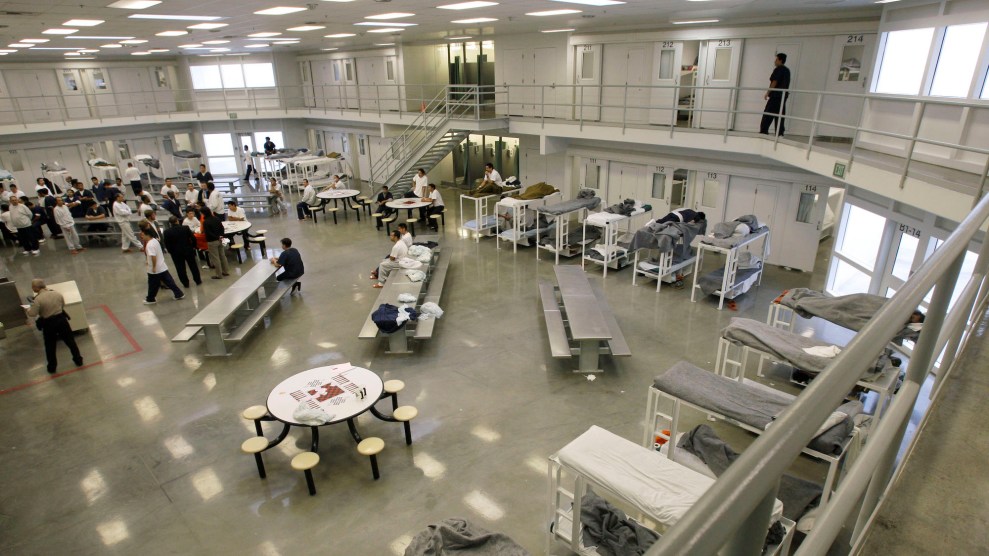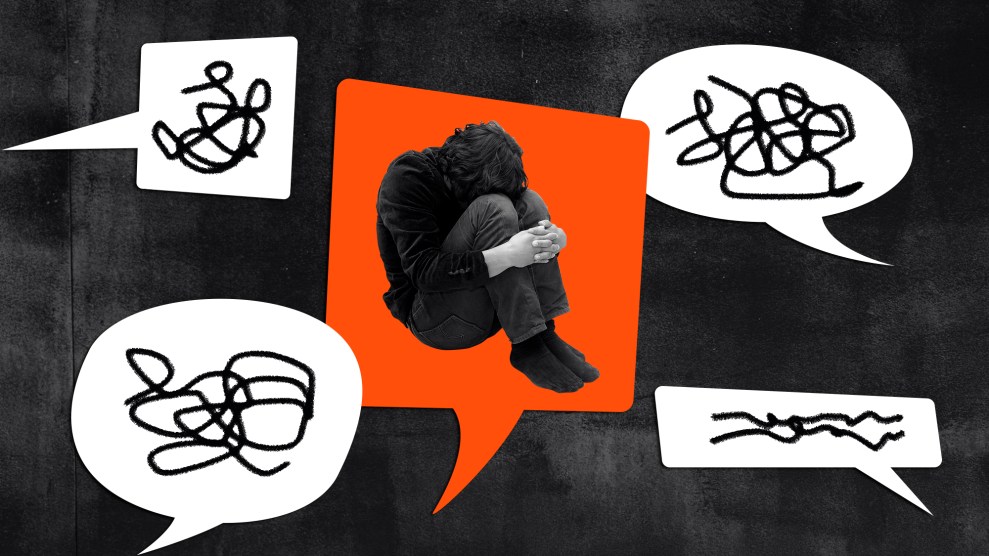
Immigration detainees leave the cafeteria under the watch of guards. Gerald Herbert/AP
On June 15, Jhon Javier Benavides-Quintana, an Ecuadoran immigrant, died of undetermined causes in the Otero County Processing Center, a detention center in New Mexico. He was 32 years old. The American Civil Liberties Union (ACLU), which recently filed a civil rights complaint on behalf of the detainees at Otero over “retaliatory use of solitary confinement,” has called for an investigation. The detention center is owned by Otero County but run by the private prison operator Management & Training Corporation. Benavides-Quintana’s death occurred less than a month after two other immigrants died while in US Immigration and Customs Enforcement (ICE) custody in Georgia and Michigan.
Now, a new report by the ACLU, Physicians for Human Rights, and the nonprofit watchdog American Oversight reveals how “systemic failures in medical and mental health care in ICE detention have caused otherwise preventable deaths.” The study, titled Deadly Failures, relies on 14,000 pages of documents, including detainee death reviews, autopsy reports, and emails obtained through public records requests. ICE currently detains an average of 36,000 people a day across about 135 facilities nationwide. Like Benavides-Quintana, the vast majority of immigrant detainees are held in detention centers run by private companies
Medical experts consulted for the analysis concluded that 95 percent of the deaths in custody, or 49 of the 52 incidents reported by ICE from January 2017 to December 2021, were preventable, or possibly preventable, had the detainee received adequate medical care. The study doesn’t analyze deaths up to the present, the authors say, because ICE failed to release full records in a timely fashion.
But it is known that, between 2017 and May 2024, ICE has reported at least 69 deaths in custody. In 13 of these cases, the agency hasn’t publicly disclosed the reasons why. Suicide is responsible for the deaths for 14 of the people whose cause of death is known. The numbers don’t include those who were released by ICE while in the hospital and subsequently died. “This suggests the death toll of people detained by ICE is likely higher than officially reported,” the study says.
In 88 percent of the cases reviewed, medical staff in the detention facilities made wrong or incomplete diagnoses. Delays in providing emergency care and inadequate mental health help also contributed to the deaths. In almost two-thirds of the cases that were reviewed, detention officers “falsified or made improper or insufficient documentation” about the attention patients received. At a detention center in Florida, for example, staff lied about having checked on a detainee hours before the man was found dead.
ICE’s “investigation, formal analyses, and recommendations in response to deaths in custody are structured to avoid fault and disclaim agency accountability.”
Researchers also found several flaws in the agency’s oversight and accountability mechanisms, concluding they “do little to prevent future deaths.” ICE investigations staff failed to interview witnesses, allowed the destruction of evidence, and omitted facts “that may embarrass, or suggest fault by, detention facilities or ICE,” from their reports. ICE’s “investigation, formal analyses, and recommendations in response to deaths in custody are structured to avoid fault and disclaim agency accountability,” the authors concluded.
In one case cited in the report, when a Spanish-speaking detainee told staff at Kay County Detention Center in Newkirk, Oklahoma, that she felt “like she was dying,” they dismissed it as suicidal ideation. The woman was put in solitary confinement and later died from liver failure. Investigators of this death never disclosed the mistaken interpretation.
The detention centers with the highest number of deaths include two facilities run by the private prison empire CoreCivic: Stewart Detention Center in Georgia, and Otay Mesa in California. In 2022, ICE contracts were responsible for $552.2 million, or 30 percent of CoreCivic’s total revenue. (Read my former colleague Shane Bauer’s 2018 investigation into CoreCivic here.) Moreover, according to the report, deaths in custody rarely lead to consequences for the facilities. ICE didn’t terminate any agreements with detention centers that failed to meet standards. In the period between 2017 and June 2024, the agency issued fines on just three occasions. In some instances, the agency even expanded its agreement with contractors.
The authors of the report call on ICE to stop relying on mass detention and urge the agency to promptly release vulnerable detainees. “Each of these deaths represents a preventable tragedy, and underscores the systematic danger posed by placing people in immigration detention,” Eunice Cho, c0-author of the report and senior staff attorney at the ACLU’s National Prison Project, said in a statement. “ICE has failed to provide adequate—even basic—medical and mental health care and ensure that people in detention are treated with dignity.”
















